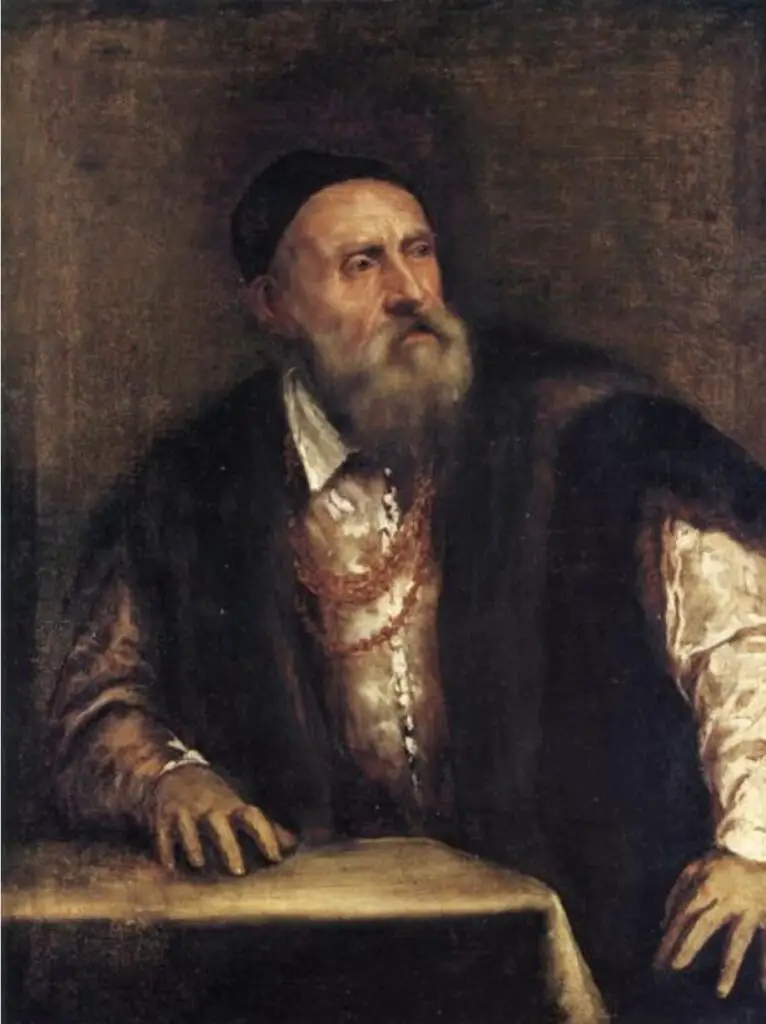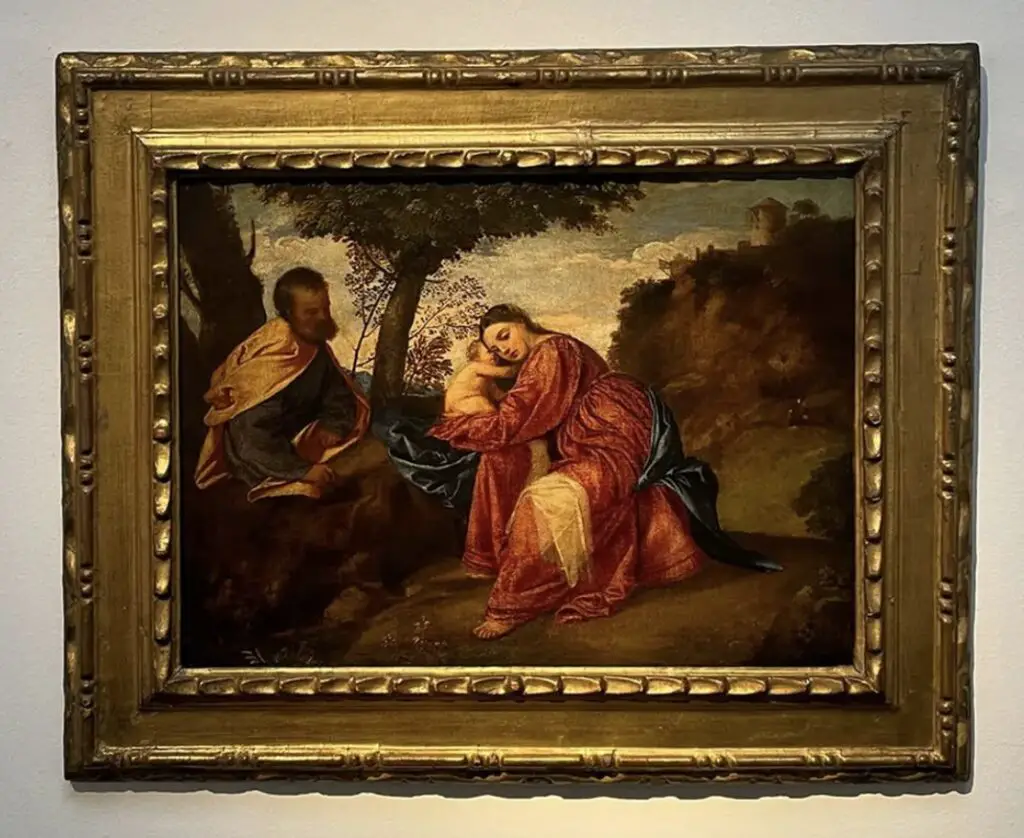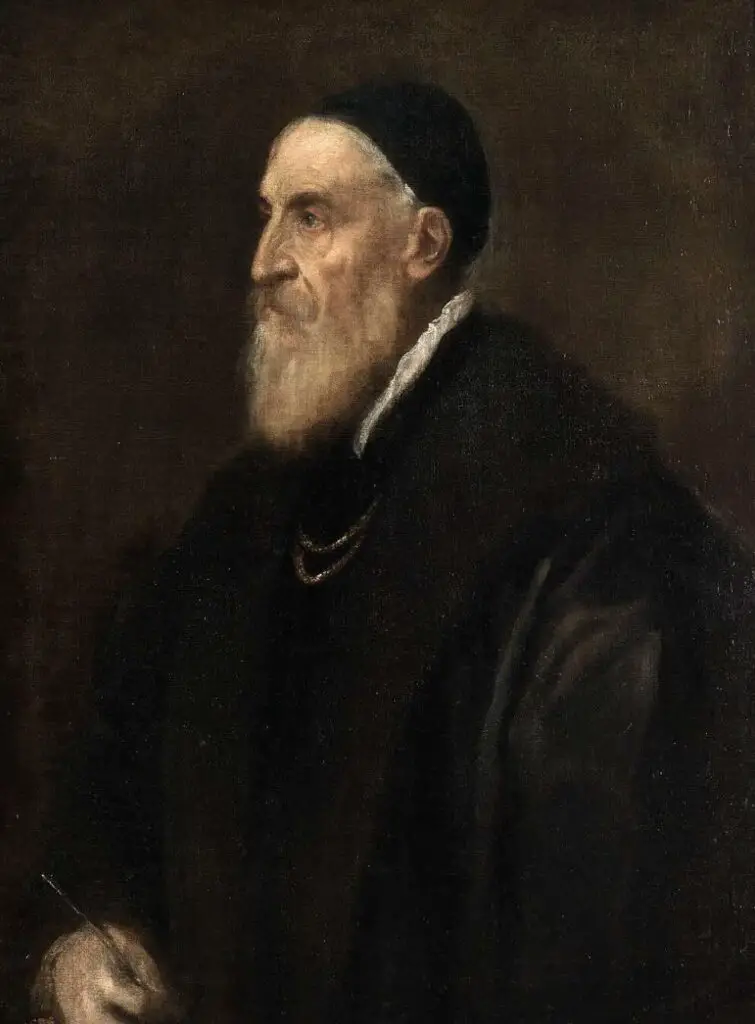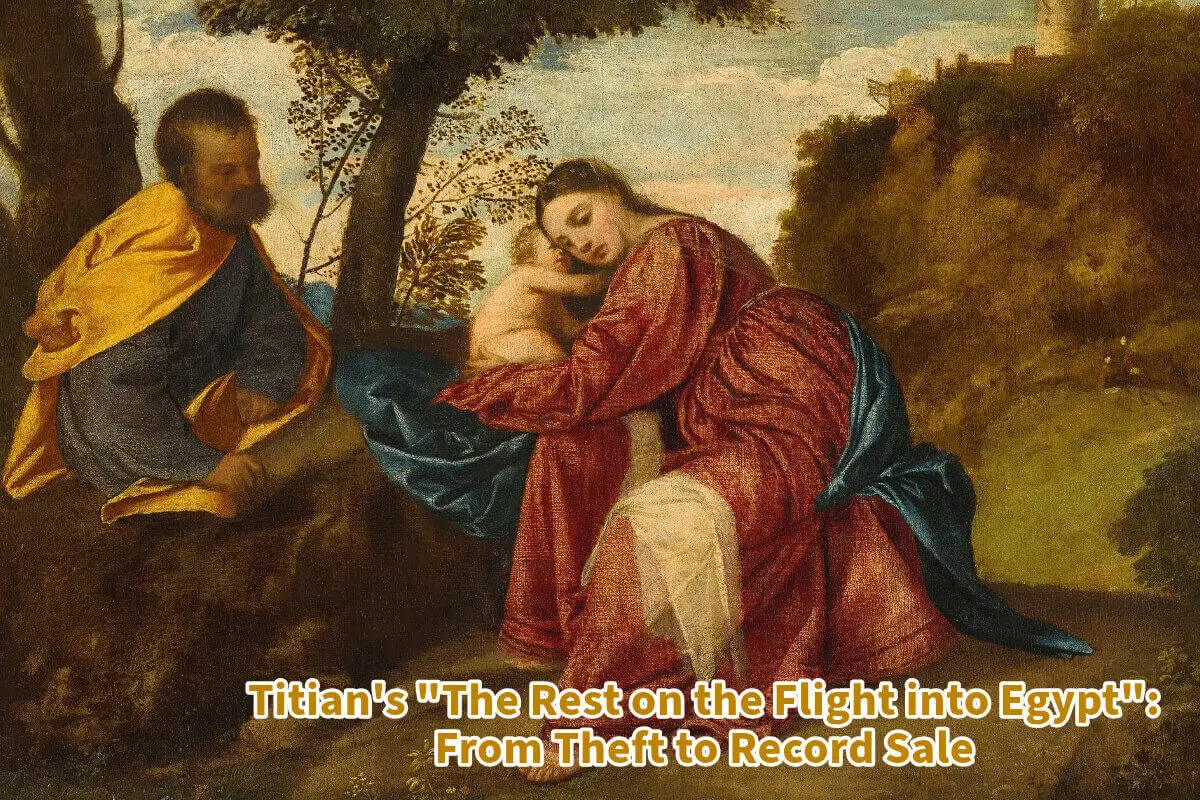Few stories are as captivating in the annals of art history as the saga of Titian’s “The Rest on the Flight into Egypt.”
This early masterpiece by the Venetian Renaissance painter has traversed centuries, continents, and tumultuous events, only to re-emerge most unexpectedly and achieve a record-breaking sale. In 1995, the painting was stolen from the home of a British marquess, sparking a worldwide search. Seven years later, it was astonishingly found in a plastic bag at a London bus stop. Recently, the painting sold for over $22 million at Christie’s, marking a historic moment for the art market. Read on as we go into the artist behind the work, the significance of the painting, and its extraordinary provenance.
Table of Contents
- Who Was Titian?
- “The Rest on the Flight into Egypt”: The Painting and Its Significance
- The Painting’s Provenance: A Tale of Royalty and Intrigue
- Related Questions
Who Was Titian?
Titian, born Tiziano Vecellio around 1488/1490 in Pieve di Cadore, near Belluno, was one of the greatest painters of the Italian Renaissance. Renowned for his mastery of color, use of light, and innovative compositions, Titian’s work spanned religious subjects, mythological scenes, and portraits.

He was a student of Giovanni Bellini and was heavily influenced by Giorgione, another Venetian master. However, Titian’s genius soon surpassed his contemporaries, earning him a place among the most celebrated artists of his time.
Titian’s importance in art history is manifold. He was a pioneering figure in the development of Venetian painting, known for his ability to imbue his works with realism and emotional depth.
His revolutionary technique of applying layers of paint to create a rich, textured surface contributed to the luminosity and depth that characterized his works. Titian’s influence extended beyond his lifetime, impacting later artists such as Peter Paul Rubens, Diego Velázquez, and even the French Impressionists. His works are considered masterpieces of the High Renaissance and are housed in major museums worldwide.
“The Rest on the Flight into Egypt”: The Painting and Its Significance
“The Rest on the Flight into Egypt” is a small yet significant painting by Titian, believed to have been created around 1510. The painting portrays a poignant moment from the biblical narrative, where Joseph, Mary, and the infant Jesus flee to Egypt to escape King Herod’s massacre.
The composition captures a quiet moment of respite during their journey, with Mary cradling the child Jesus while Joseph watches over them in a serene rural landscape.
The painting is notable for its vibrant colors and the masterful use of light, typical of Titian’s early work. The primary hues, such as the deep red of Mary’s robe and the ultramarine blue of her cloak, stand out against the softer tones of the background, creating a striking visual contrast.
The luminosity and depth of the colors enhance the scene’s emotional resonance, evoking a sense of peace and divine protection.
Beyond its aesthetic qualities, “The Rest on the Flight into Egypt” is significant for its historical and cultural context. While it is not documented who originally commissioned the painting, its early presence in the collection of a Venetian spice merchant suggests it was valued from the outset.
The work reflects the religious and cultural milieu of Renaissance Venice, where biblical themes were a common subject for artistic exploration.
The Painting’s Provenance: A Tale of Royalty and Intrigue
The provenance of “The Rest on the Flight into Egypt” is as fascinating as the painting. Illustrious owners and dramatic events have marked the artwork’s journey through history.

In the early 17th century, it was part of a collection owned by a Venetian spice merchant, indicating its early appreciation and value. The painting later passed into the hands of notable figures, including an English duke and Archduke Leopold Wilhelm of Austria, a prominent art collector of his time.
One of the most tumultuous episodes in the painting’s history occurred during the Napoleonic Wars. Napoleon’s troops, known for their systematic looting of European art, seized the painting from Vienna.
After Napoleon’s defeat, the artwork was returned to the city, symbolizing the restoration of cultural heritage. This episode underscores the painting’s significance, as it was deemed valuable enough to be part of Napoleon’s vast art collection.
In 1878, the painting was acquired by John Alexander Thynne, the 4th Marquess of Bath, becoming part of the Longleat House collection in Wiltshire, southwest England. The Thynne family, known for their patronage of the arts, held the painting for over a century.
However, the painting’s tranquil existence at Longleat was shattered in 1995 when it was stolen, sparking an international art theft investigation.
The Theft and Miraculous Recovery
The theft of “The Rest on the Flight into Egypt” was a significant loss to the art world and the Thynne family. In 1995, the painting and several other valuable items were stolen from Longleat House.
The theft was a high-profile case, attracting widespread media attention and prompting a global search. Despite extensive investigations, the painting remained missing for several years.
In 2002, the story took a surprising turn. Charles Hill, a renowned art detective, was involved in a sting operation that led to the painting’s recovery. Astonishingly, the masterpiece was found in a plain white and blue plastic bag at a bus stop in southwest London.
The painting, though missing its frame, was otherwise intact. The recovery was hailed as a miracle, considering the delicate nature of the artwork and the challenges associated with retrieving stolen art.
The circumstances of the painting’s theft and recovery remain shrouded in mystery. The art world speculated on the motives behind the theft, the identity of the thieves, and the reasons for its abandonment.
Some theories suggest that the painting’s high-profile nature made it difficult to sell, leading the thieves to abandon it. Regardless of the reasons, the recovery of “The Rest on the Flight into Egypt” was a significant victory for art preservation and law enforcement.

A Record-Breaking Sale at Christie’s
The saga of “The Rest on the Flight into Egypt” reached a new chapter in 2024 when the painting was sold at Christie’s auction house for over $22 million. The sale set a new record for Titian, underscoring the artist’s enduring appeal and historical significance.
Christie’s billed the painting as the most important work by Titian to come to the auction market in more than a generation, attracting attention from collectors and institutions worldwide.
The auction was highly anticipated, with experts and enthusiasts eager to see the outcome. The final sale price reflects the painting’s artistic and historical value and highlights the market’s interest in Renaissance art.
The record sale also reaffirms Titian’s status as one of the greatest painters of the 16th century, whose works continue to captivate audiences centuries after their creation.
The proceeds from the sale will benefit the current owners and the Thynne family and potentially fund further conservation efforts or acquisitions.
The painting’s sale also contributes to the broader art market, influencing the valuation and appreciation of Renaissance masterpieces. The auction’s success is a testament to the timelessness of Titian’s work and the continued fascination with his art.

The Fascinating Journey of Titan’s Painting
The journey of Titian’s “The Rest on the Flight into Egypt” is a remarkable tale of art, history, and intrigue. From its creation in the early 16th century to its record-breaking sale in 2024, the painting has traversed a path filled with drama and significance.
Its theft and subsequent recovery highlight the challenges and triumphs of art preservation, while its sale underscores Titian’s work’s enduring value.
As one of the most influential artists of the Renaissance, Titian’s legacy continues to influence and inspire. His mastery of color, light, and composition set new standards in art, and his works remain revered and sought after.
“The Rest on the Flight into Egypt” is a testament to Titian’s genius. It captures a moment of divine peace and protection with stunning beauty and emotion.
The painting’s journey also serves as a reminder of the importance of art conservation and the need to protect cultural heritage. Whether hanging in a grand palace or a modern museum, works like Titian’s connect us to our shared history and cultural identity.
As the painting begins a new chapter in its long and storied life, it will continue to enchant and inspire for generations to come.
Listen To Our Podcast About
How Did Titian’s “The Rest on the Flight into Egypt” Go from Theft to Record Sale? Below or By clicking here.

Anita Louise Art is dedicated to art education, great artists, and inspiring others to find and create their art. We love art that uplifts and inspires. #ArtToMakeYouSmile! #ArtToMakeYouHappy!
If you are interested to see any of my art, you can find out more by clicking here. If you are interested in what inspires me and my paintings, you can discover more by clicking here.
We have a free newsletter and would love you to be part of our community; you can subscribe to the newsletter by clicking here. I would be happy to talk to you if you have any questions. You can reach me, Anita, by clicking here.
Subscribe to our Anita Louise Art YouTube Channel with great videos and information by clicking here.
Join us for our podcast “5 Minutes With Art.” Spend just 5 minutes a week with us to discover and learn about great art and artists. You can find out more about our podcast by clicking here.
Related Questions
What Is The Cultural Significance Of Abstract Expressionism Art?
The cultural significance of abstract expressionism art is that it was a forerunner for the cultural changes in the United States in the 1950s and 1960s. The Abstract Expressionism movement started after World War II in the 1940s and continued into the 1950s. The world saw great cultural shifts in the 1950s and the 1960s.
By clicking here, you can learn more by reading What Is The Cultural Significance Of Abstract Expressionism Art?.
Who is the American Artist Jackson Pollock (1912-1956)?
Some consider Jackson Pollock to be one of the most brilliant American abstract artists that ever lived. Others consider his work of art as tossing around cans of paint by an artistic madman. One thing for certain is that Jackson Pollock is an important American abstract artist.
You can learn more by reading the blog Who is the American Artist Jackson Pollock (1912-1956)? by clicking here.
What Type Of Artist Is Andy Warhol?
Andy Warhol is a Pop Artist, one of the Pop Art Movement’s major figures. Andy Warhol’s artwork explored the relationship between what is known as the mass popular cultures of his day and art. He used many iconic American objects in his art and also painted many celebrities.
You can read more by reading our blog What Type Of Artist Is Andy Warhol? by clicking here.

